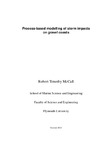Process-based modelling of storm impacts on gravel coasts
| dc.contributor.supervisor | Masselink, Gerd | |
| dc.contributor.author | McCall, Robert Timothy | |
| dc.contributor.other | Faculty of Science and Engineering | en_US |
| dc.date.accessioned | 2015-12-11T10:31:16Z | |
| dc.date.available | 2015-12-11T10:31:16Z | |
| dc.date.issued | 2015 | |
| dc.date.issued | 2015 | |
| dc.identifier | 10304733 | en_US |
| dc.identifier.uri | http://hdl.handle.net/10026.1/3929 | |
| dc.description | Full version unavailable due to 3rd party copyright restrictions. | |
| dc.description.abstract |
Gravel beaches and barriers occur on many high-latitude, wave-dominated coasts across the world. Due to their natural ability to dissipate large amounts of wave energy, gravel coasts are widely regarded as an effective and sustainable form of coastal defence. However, during extreme events waves may overtop, overwash, and even lower, the crest of the gravel beach, flooding the hinterland. In the evaluation of the safety of gravel coasts against flooding, coastal managers currently rely on models that have been shown in previous studies to be inaccurate. The research in this thesis attempts to improve the current predictive capacity of gravel beach storm response by developing a new process-based model to simulate storm impacts on gravel coasts. The numerical model developed in this thesis, called XBeach-G, is a morphodynamic, depth-averaged, cross-shore profile model, based on the XBeach model for sandy coasts (Roelvink et al., 2009). The model simulates the morphological response of gravel beaches and barriers to storms by solving: (1) intra-wave flow and surface elevation variations using a non-hydrostatic extension of the non-linear shallow water equations; (2) groundwater processes, including infiltration and exfiltration, using a Darcy-Forchheimer-type model; and (3) bed load transport of gravel using a modification of the Van Rijn (2007a) bed load transport equation to include flow acceleration effects, which are shown to be significant on coarse-grained beaches. The model is extensively validated for hydrodynamics, groundwater dynamics and morphodynamics using detailed data collected in physical model experiments, as well as data collected in the field on four natural gravel beaches in the UK and one in France. Validation results show that the model has high quantitative skill in simulating observed hydrodynamics on gravel beaches across a wide range of forcing conditions, in particular with regard to wave transformation, wave run-up and wave overtopping. Spatial and temporal variations in groundwater head are shown to be well represented in the model through comparison to data recorded in a physical model experiment. Validation of the morphodynamic component of XBeach-G shows that the model has high model skill (median BSS 0.75) in simulating storm impacts on five gravel beaches during ten storm events, with observed morphodynamic response ranging from berm-building to barrier rollover. The model is used to investigate hydrodynamic processes on gravel beaches during storms, where it is found that incident-band variance is elemental in the generation of wave run-up on gravel beaches. Furthermore, simulations of wave run-up during high-energy wave events show a distinct disparity between run-up predicted by empirical relations based on the Iribarren parameter and wave steepness, and run-up predicted by XBeach-G, where predictions by the empirical relations substantially underestimate observed wave run-up. Groundwater processes are shown, by means of sensitivity simulations, to strongly affect the morphodynamic response of gravel beaches and barriers to storms. The research in this thesis supports the hypothesis that infiltration in the swash is a key driver for the berm-building response of gravel beaches and helps to reduce erosion of the upper beach during storms. Through model simulations on a schematic gravel barrier it is shown that groundwater processes effectively increases the capacity of gravel barriers to withstand storms with 1-3 m higher surge levels than if groundwater processes did not occur. Reducing the width of a barrier leads to a lowering of this capacity, thereby reducing the resilience of the barrier to extreme storm events. Despite its strong influence on gravel beach morphodynamics, it is found that infiltration plays a relatively small role on wave run-up levels on most natural gravel beaches (median R 2% run-up level reduction of 8%). Application of the model in validation simulations and sensitivity simulations in this thesis, as well as in storm hindcast simulations discussed by McCall et al. (2013) shows the value of using the process-based XBeach-G model in coastal flooding analysis over the use of empirical tools. While no model can be considered entirely accurate, application of XBeach-G in all hindcast overwash simulations has lead to reasonable estimates of overtopping discharge and of morphological change, which is a significant improvement over the frequently substantial errors of the empirical tool designed for this purpose. | en_US |
| dc.description.sponsorship | EPSRC | en_US |
| dc.language.iso | en | en_US |
| dc.publisher | Plymouth University | en_US |
| dc.subject | Gravel | en_US |
| dc.subject | Shingle | en_US |
| dc.subject | Storm morphology | en_US |
| dc.subject | Overwash | en_US |
| dc.subject | Erosion | en_US |
| dc.subject | Modelling | en_US |
| dc.title | Process-based modelling of storm impacts on gravel coasts | en_US |
| dc.type | Thesis | |
| plymouth.version | Full version | en_US |
| dc.identifier.doi | http://dx.doi.org/10.24382/4403 |
Files in this item
This item appears in the following Collection(s)
-
01 Research Theses Main Collection
Research Theses Main


